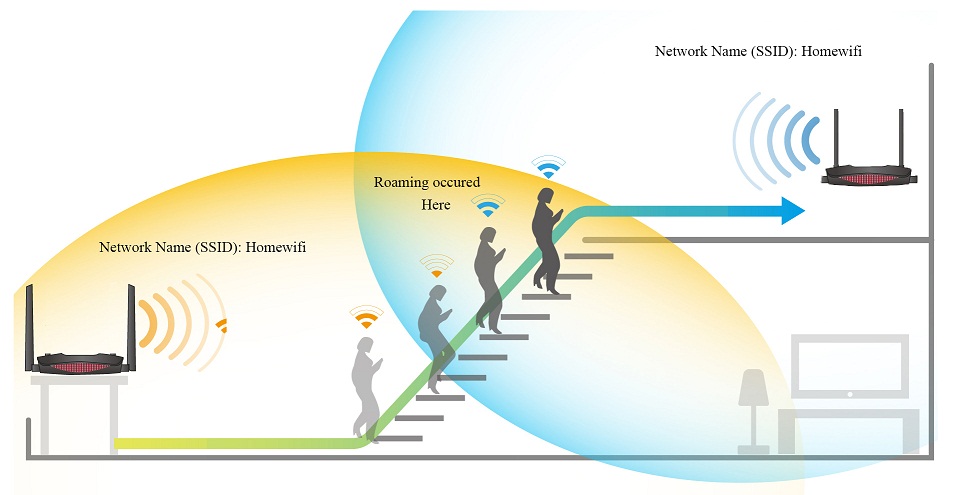
What is Wi-Fi Roaming?
Have you ever wondered how your WiFi connection follows you around the building? This useful networking feature is called Roaming. WiFi roaming occurs when a wireless client device moves outside the usable range of one router or access point (AP) and connects to a different one. The client device automatically switches from one router (or access point) to another extender or mesh access point as needed to provide seamless connectivity. In this ideal scenario, you will not experience the inconvenience of choppy video calls and low download speeds when walking from one side of a building to another.

Credit: Wifi Adviser
How does WiFi Roaming work?
In theory, WiFi roaming works similarly to cell phone roaming. You need to have multiple access points throughout the building – be it a hospital, school, workplace, etc., so that as soon as you're near the outer limits of one of the access point's range, your device is already in the range of another. In order to work seamlessly, all of the WiFi access points in the network need to be configured to use the same SSID (or network name) and the same login credentials.
However, WiFi roaming is decided by the client device, like your cellphone or laptop. WiFi Standards organizations (e.g. IEEE802.11 and WiFi Alliance) do not specify when or how a client device should roam. The wireless client device is responsible for deciding if it needs to roam and then detecting, evaluating, and roaming to another access point. There are 3 phases to this process:
- Scanning: As the signal strength weakens as you move away from a point, the client device sends out probe packets to identify possible alternative access points. The device then selects its next access point based on the specifications of the device itself.
- Authentication: The client device sends a request to the selected access point to be authenticated and awaits a response from the new access point that will either accept or reject it.
- Re-association: When (and if) the access point accepts the client device's request, the client device sends yet another request, this time a re-association one. When the re-association is complete, the new access point sends out a disassociation packet to the former access point. The old access point is then disconnected, and the routing tables are updated.
Benefits of WiFi Roaming
Mobility is an essential feature of WiFi networks, but building a WiFi network that provides continuous coverage throughout a building can be difficult, especially as coverage demands grow. If you have ever experienced a sudden drop in connection speed while walking across a building, you know what we mean. The issue that most likely caused the drops in your connection was the network's failure to support roaming. This issue can be solved by deploying the right network design.
WiFi Roaming allows you to freely move from room to room while your device automatically roams from one access point to another as necessary, intuitively choosing the strongest access point without dropping its WiFi signal, providing seamless connectivity. While there's always a brief interruption when switching between networks – around half a second – when roaming, the duration of that interruption can be reduced to a minimum if the devices use the same WiFi network names (SSID's), WiFi channels, and network keys.

Common Issues with Wi-Fi Roaming
There are two main issues when it comes to Wi-Fi Roaming:
- The client device that is using WiFi Roaming does not connect to the optimal access point. For example, a client device can be connected to a weak access point (in terms of signal strength) even though there is another access point available that can provide much stronger signal strengths,
- The handover between access points is not always flawless. There can be device drop-off and delays.
Installing more access points in an area can potentially increase the chances of a client device connecting to the optimal access point.
However, proper WiFi roaming requires more than just good signal strength throughout coverage areas. A balance between the coverage of access points on both the 2.4 and 5 GHz bands is needed to make roaming work properly.
How to Optimize Your Network
For WiFi Roaming to be beneficial for the user, the user's device must connect to the optimal access point, and the handover process between access points must be smooth. The user device should be connected to a particular WiFi network and should constantly be scanning for other access points with the same SSID. If an access point with a better signal is found, the user device should seamlessly connect to it and drop the previous connection. This handover should not result in a poor experience for the end-user.
As mentioned earlier, installing more access points can be an easy fix, but it doesn't always work. Ensuring WiFi roaming is successful requires more than just strong signal coverage. It requires each access point's coverage to be balanced on both the 2.4 and 5 GHz bands. But what does have "balanced" access points mean?
To optimize and balance access points, you can consider these tips:
- Overlap your mesh nodes or extenders by 15-20% - Too much overlap can cause access points to become overloaded and devices may repeatedly jump between nodes and become unstable. With too little overlap, users may experience temporary drop-offs.
- Signal boundary between access points should be about –67 dBm (decibels relative to a milliwatt). A dBm essentially measures the power of a signal being transmitted from an access point. The closer the dBm measurement is to 0, the better the signal strength is. -67 dBm is the minimum signal strength necessary for a client device to have stable and fast access to the internet. Thus, access points need to be placed and overlapped in a way that prevents any device from leaving the –67 dBm range. It is important to consider both the 2.4 and 5 GHz bands while evaluating signal strength in areas, as the range of the 2.4 GHz band is larger than the range of the 5 GHz band.
Did you know that Mercku M2 and Mercku M6 routers support WiFi roaming?
Learn more about this and more on Mercku.com.
For more information about Mercku's Connectivity Suite, our hardware and how you can partner with Mercku, please reach out to the team at connect@mercku.com
Thank you for reading our blog! Mercku Blogs covers the latest in wireless technology - subscribe to our newsletter to make sure you don't miss our newest releases!

